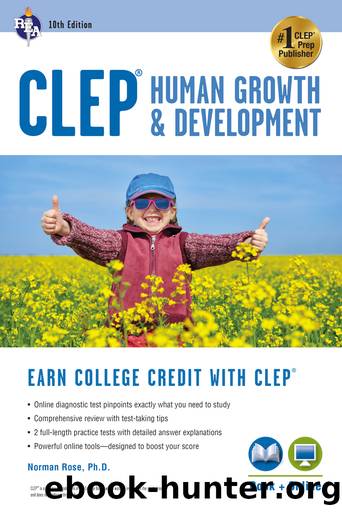CLEP Human Growth & Development, 10th Ed., Book + Online by Norman Rose

Author:Norman Rose
Language: eng
Format: epub
Publisher: Research & Education Association
Published: 2019-01-15T00:00:00+00:00
DEVELOPMENT OF EMOTIONS
Robert Plutchik proposed that emotions evolved because they help a species to survive. He asserted that emotions are inherited behavioral patterns and are modified by experience. Emotions have four components: external stimuli that are interpreted by the person, feelings, physiological arousal, and behavioral responses. However, there are various theories that attempt to explain the origin and order of our experience of emotions.
William James and Carl Lange theorized that people experience physiological changes and interpret these changes as emotions. In other words, emotions follow behavior and not vice versa. Under this theory, the dog does not run because it is scared; it is scared because it runs.
Walter Cannon and colleague Philip Bard noted that the physiological changes in many emotional states were identical. For instance, if someone reports sweaty palms, pounding heart, and tension, is that love, jealousy, fear, or hate? Because of this, people cannot determine their emotional state only from their physiological state. The Cannon-Bard Theory argues that emotion occurs when the thalamus sends signals simultaneously to the brain cortex and to the autonomic nervous system.
Stanley Schachter and Jerome Singer offered a cognitive approach to emotions. It is referred to as the Schachter-Singer Two-Factor Theory. This theory proposes that emotion occurs when physiological arousal causes us to search for reasons for this arousal. We examine the environment for an explanation for this arousal. Emotions are determined, therefore, by labeling our arousal based on what is occurring in our environment.
Other researchers have studied the origin of emotions in humans. Paul Ekman and his colleagues studied peopleâs ability to judge emotions based on facial expressions in photographs of adults. (They are somewhat successful at recognizing emotional expressions in photographs of infants as well.) The researchers found that there are six facial expressions corresponding to six emotions that people can recognize, and that this interpretation of facial expressions is universal. Out of that, it was proposed that there are six basic emotions: happiness, anger, disgust, sadness, fear, and surprise.
Secondary emotions are understood to be shadings and combinations of those basic ones. For instance, hurt is sadness plus anger, worry is sadness plus fear. Curious is a combination of surprise and happiness, while startled is a combination of surprise and fear. There are also social emotions that develop, such as embarrassment and empathy.
Newborns do not seem to have a set of emotions. They do, however, exhibit one negative emotion: distress. Other psychologists argue that infants are born with the emotions of interest, distress, and disgust. Joy develops between four and six weeks; anger, surprise, sadness, fear, and shame between three and eight months; and contempt and guilt in the second year. Critics argue that infants may experience all these emotions before they can express them.
Psychologists do agree that there is a biological component to emotion, but that emotions are also affected by experience. Learning theory (behaviorism) suggests that emotional responses are learned through classical conditioning or observational learning. Classical conditioning theory would explain a childâs fear of dogs as a conditioned response.
Download
This site does not store any files on its server. We only index and link to content provided by other sites. Please contact the content providers to delete copyright contents if any and email us, we'll remove relevant links or contents immediately.
Barron's AP Biology by Goldberg M.S. Deborah T(4097)
ACT Math For Dummies by Zegarelli Mark(3994)
What It Really Takes to Get Into Ivy League and Other Highly Selective Colleges by Hughes Chuck(3696)
5 Steps to a 5 AP U.S. History, 2010-2011 Edition (5 Steps to a 5 on the Advanced Placement Examinations Series) by Armstrong Stephen(3689)
McGraw-Hill's SAT 2014 Edition (Mcgraw Hill's Sat) by Black Christopher & Anestis Mark(3388)
Kick Ass in College: Highest Rated "How to Study in College" Book | 77 Ninja Study Skills Tips and Career Strategies | Motivational for College Students: A Guerrilla Guide to College Success by Fox Gunnar(3075)
Graduate Admissions Essays, Fourth Edition: Write Your Way into the Graduate School of Your Choice (Graduate Admissions Essays: Write Your Way Into the) by Asher Donald(2876)
Get into Any College by Tanabe Gen Tanabe Kelly(2686)
Easy Algebra Step-by-Step by Sandra Luna McCune(2583)
500 Must-Know AP Microeconomics/Macroeconomics Questions(2529)
The Official Guide to the TOEFL Test by ETS(2287)
Cracking the Sat French Subject Test, 2013-2014 Edition by The Princeton Review(1828)
Open the Gates to the Ivy League: A Plan B for Getting into the Top Colleges by C. W. Henderson(1799)
Barron's AP Calculus by David Bock(1777)
Law School Essays that Made a Difference by Princeton Review(1761)
Cracking the SAT Literature Subject Test, 2013-2014 Edition (College Test Preparation) by Princeton Review(1724)
Barron's SAT Math Workbook by Lawrence S. Leff(1700)
Cracking the AP Physics C Exam, 2018 Edition by Princeton Review(1681)
ASVAB AFQT For Dummies by Rod Powers(1619)
